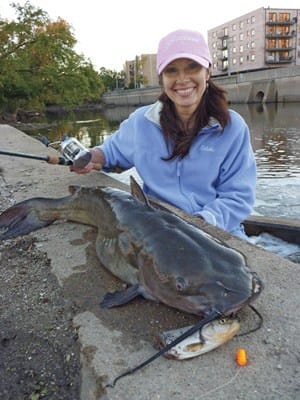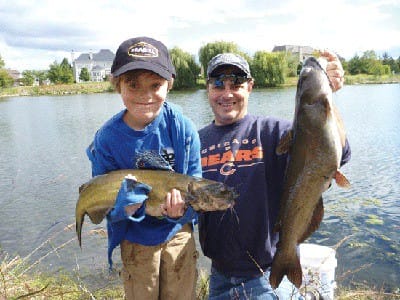by Steve Ryan, In-Fisherman

The scene may be different, but presentation principles play out just the same as in wilderness settings.
Welcome to the urban jungle, constructed of concrete, steel and glass. Skyscrapers, expressways, parking lots and crowded housing dominate the landscape. The city smothers out the natural world. With land at a premium, nothing resembling a pristine natural waterway exists here. How can a catfish angler survive?
By exploring small-water options, quality channel catfish opportunities are discoverable in most cities across North America. No need to escape the city for more rural surroundings or trailer a boat to one of the major rivers in the area. Instead, savvy anglers can adapt to what the mean streets have to offer and catch their share of channel catfish from small residential ponds and a network of small rivers, channels and creeks that course through these metropolitan areas.
Up a Creek Without a Paddle
Many of the nation’s cities were formed around waterways used for trading, hydropower and transportation. My hometown of Chicago sits ashore Lake Michigan, where the Chicago River once emptied into it. The past tense is used since, through an engineering marvel, the flow of the Chicago River was reversed to keep industrial waste and sewage dumped in the river from flowing into Lake Michigan and contaminating the city’s water supply. On a positive note, the advent of the EPA and stricter municipal codes have vastly improved water quality and catfish fisheries. Even so, catch and release is a good idea on many urban waterways.
To see just how many miles of fishable water are connected in urban settings, take Chicago as an example. The mouth of the Chicago River starts at Lake Michigan, in the shadows of downtown skyscrapers. The river quickly splits into the North and South branches. The North Branch runs along abandoned industrial sites, old tanneries, and breweries, before quickly narrowing as it meanders through backyards halfway to the Wisconsin border.
The South Branch links with the artificially constructed Chicago Sanitary and Ship Canal, which joins with the Des Plaines River and in turn empties into the Illinois River. Several hundred miles downstream, the Illinois River feeds the Mississippi River just north of St. Louis. Along the way, ancillary rivers, streams, creeks and canals connect with each main river segment. On these overlooked secondary waterways, shorebound anglers keep busy catching catfish throughout the year.
Starting points to fish on small rivers and streams include confluence areas, industrial discharges and low-head dams. These areas can add oxygen, increase depth and attract baitfish and are easy to locate with minimal surveillance. Obtaining access can be difficult, but make the effort to get all necessary permissions. Be mindful that key catfish holding areas change throughout the season, so don’t get settled into an area if it ceases to produce.
Warm-water discharges can be prime from late fall through winter. Discharge sources include waste treatment plants, storm water discharges and direct point discharges from industrial facilities. Look for the steam to locate discharge sites. Even small discharge sources can increase the surrounding water temperatures by as much as 15°F. Temperature-sensitive baitfish, like shad, stack in these areas as a result.
Once spring rains spike stream flow rates, confluence areas and the lower portion of feeder creeks draw fish from larger adjacent waterways. Shallow feeder creeks that warm quickly in the spring act as natural warm-water discharges. Channel catfish remain in these areas through the spawning season. Productive locations include banks with submerged wood, riprap banks and concrete embankments that retain the day’s heat. In urban settings, don’t overlook unconventional current-break items like refrigerators, shopping carts and stripped down automobiles that have made their way into the river and serve as cover for catfish.
As the summer progresses, deeper holes continue to hold fish in even the smallest streams. Tread lightly when stalking catfish from tiny tributaries, however, as even minimum disturbance on the bank spooks fish holding in holes as shallow as 3 to 4 feet deep. In addition to deep holes, look for funnel areas below dams that add oxygen and concentrate baitfish.
Residential ponds and lakes can provide fast fishing for stocked catfish – a great setting to introduce kids to catfishing and the outdoors close to home.
What all these seasonal locations have in common is their ability to attract and retain bait. While double mocha caramel chocolate chip frappuccinos are available on every other corner, bait shops are as scarce as an honest politician in most cities. If you don’t have a local bait shop, you can collect nightcrawlers off the pavement after heavy rains or gather bait along the stream while fishing. A few online sources ship livebait to your home. Order in bulk and keep in a Frabill Worm Storage System.
As harsh as the city streets can be, the insect and aquatic world is even more resilient. Seemingly indestructible weeds and trees take hold along the water’s edge. Insects like grasshoppers, crickets and caterpillars thrive in these mini oases among the asphalt, concrete, and rebar. Frogs, crayfish, and hellgrammites fill aquatic nitches and also add to the potential menu. Urban catfishing often means finding bait as you go.
Catfish often feed on terrestrials on the surface. This action can be an added bonus in areas with minimal fishing pressure. Grab a grasshopper off the sidewalk or a caterpillar from streamside milkweed. Thread the offering on a #4 baitholder hook and cast it along a current seam or adjacent eddy. Keep the bait alive and struggling on the surface as long as possible. A mugging or something more sinister is about to occur. Make sure to get a glimpse of the assailant before he slips back into the darkness and a fight ensues.
If catfish fail to respond to surface offerings, add a split shot and drift baits deeper through the water column. Finish by presenting baits on bottom. Allow time for catfish to track down a bait using their olfactory sense. When catfish refuse a small crunchy treat, try something fishy.
With a piece of soggy grasshopper, or a slug found under a streamside rock, switch to a #8 baitholder hook to catch prime baits like creek chubs, suckers or green sunfish. Target fast runs and areas with overhanging vegetation. Use a livebait bucket with an aerator system like the Frabill Aqua-Life Bait Station to keep baits alive for the day. With two size-D batteries, the Bait Station keeps bait alive for hours, even on warm summer days. Small baits like 2- to 3-inch green sunfish or creek chubs can be fished whole. Larger 4- to 5-inch baits make fine cutbait.
Keep tackle simple. Use an easily adjustable slipsinker rig. I use 10-pound-test Trilene XL monofilament mainline, an 1/8- to 3/8-ounce egg sinker, and a 1/0 to 4/0 Owner Mutu Light circle hook. Add a split shot anywhere from a few inches to a foot above the hook to stop the egg sinker from sliding to the bait. When fishing larger chunks of cutbait, rig with a swivel rather than split shot to reduce line twist. Use heavier mainline and leader material when fishing around snags.
Few areas in smaller streams are large enough to hold more than a couple sizeable catfish, so when one spot slows, move to another. By moving frequently, the odds of connecting with active fish increases. If the fish are present and willing to feed, expect action within 15 to 20 minutes. Switch bait types at least once if you’re confident that fish are present but failing to respond to your initial offering.
Pondering Pond Options

If overcrowding in cities wasn’t bad enough, the mid-1990s to mid-2000s ushered in the housing market boom, and urban sprawl exploded. In response to this rapid growth, municipalities began to mandate the construction of retention ponds as part of each new development’s stormwater mitigation plan. For real-estate marketing purposes, developers stocked these ponds with catfish, bass and bluegills, and homeowner associations undertook supplemental stocking. Hundreds of new urban catfishing opportunities resulted.
Most retention ponds lay out like a bowl. Without any points, humps or fish-holding structure, the uniform shoreline gradually tapers out for the first 10 to 15 feet to a depth of 3 to 4 feet. This near shore apron area may be manicured with sand, with a hidden plastic liner installed to keep the immediate shoreline free of weeds. The main basin then drops off to a maximum depth of 8 to 18 feet. Weeds often grow at depths of about 3 to 8 feet.
Retention ponds have at least one input source where stormwater enters, and an output site for water to escape when maximum capacity is reached. The input side benefits from the occasional influx of fresh water and food. These areas can eventually become weed choked and unfishable due to excessive nutrients in drainage water. By mid-summer, the main basin, fountain areas and large pockets in the weeds serve as prime areas to target channel catfish.
Use two rods, where permitted, to target pond catfish. Fish a slipfloat rig along the outside edge of the weeds and a bottom rig out slightly deeper. Scent and proper bait placement become more important than stealth in pond settings. Use a highly visible slipfloat like the Super-Pro Northland Lite-Bite Bobber or Rod-N-Bobbs EZ-flo. Keep the bait a foot off the bottom and out of the weeds. Channel catfish routinely cruise these edges for food. Emerging larvae, aquatic insects, snails, crayfish, and young-of-the-year fish are attracted to these soft-bottom weedy areas.
With bait shops not readily available, consider raiding the pantry or taking a trip to the local supermarket to obtain bait. Your grocery list could include any of the following: chicken livers, hot dogs, spam, shrimp, past-date lunchmeat, or corn. If it emits a strong odor, catfish find it. Berkley also makes several varieties of Gulp! that catfish like, including Catfish Dough, Catfish Chunks, Shad Guts, Corn, and Earthworms. Stinkbaits offer yet another option.
In most ponds, an 8- to 10-pound-test mono mainline is sufficient for fishing channel catfish in moderately weedy conditions. Switch to 30-pound Spiderwire with a 20-pound-test Vanish fluorocarbon leader in heavy weeds. Most 6- to 7-foot medium-action spinning or casting rods do fine for pond fishing. Since the main basin of most ponds is a uniform depth, there’s no need for long casts to the middle of the pond. Use just enough weight to keep the bait firmly on bottom and to avoid having the wind catch the line and draw the bait up against the shoreline.
Part of the fun of fishing catfish ponds is locating them and gaining access. If you don’t have a retention pond in your backyard, the easiest way to find them is to network. Ask family members, friends and coworkers if they have access to a pond. Check with your city hall or parks department, too. They often keep lists and maps of all the local parks with public-access ponds. For hidden gems, hop on Google Earth, or one of the other websites that offer aerial or satellite images, find your house, and expand out from there. You might find the next great catfish fishery in your ‘hood.
Catfish In-Sider Guide Contributor and multispecies angler Steve Ryan lives in Des Plaines, Illinois. This article was contributed by In-Fisherman, a publication of Intermedia Outdoors. Visit http://www.in-fisherman.com/ for more useful fishing articles.



